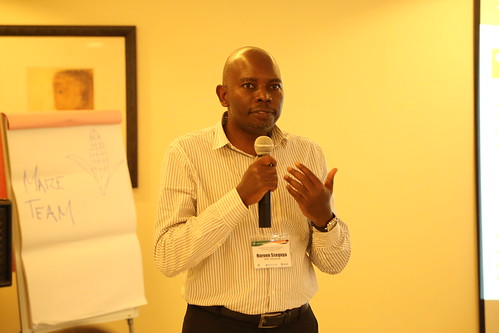RISING voices: Haroon Sseguya, technology scaling specialist at the International Institute of Tropical Agriculture (IITA)

Haroon Sseguya, technology scaling specialist at the International Institute of Tropical Agriculture (IITA), introduces himself and his work with the program. It is one of a series of portraits of key people in Africa RISING.
Tell us about your background
I was born in southwest Uganda near Lake Victoria. I have a Bsc and MSc in agricultural sciences from Uganda’s Makerere University and a PhD in sustainable agriculture and sociology from Iowa State University, USA.
Give us a brief overview of what you do in your current position
Before joining IITA as technology scaling specialist, I worked with the government in Uganda as an agricultural extension officer and as a lecturer at Makerere University. My PhD research was in a livelihoods improvement program in southeast Uganda, led by the Center for Sustainable Rural Livelihood (CSRL) of Iowa State University. I led monitoring and evaluation, communication and extension support activities in the program and this is where I got hands-on experience in scaling up technologies.
Can you tell us about your project in IITA?
The project I am supporting in IITA is a scaling project funded by the United States Agency for International Development (USAID) in partnership with Africa RISING and the other two USAID-funded projects— NAFAKA and Tuboreshe Chakula (Let’s Improve Food) in Tanzania. NAFAKA focuses on enhancing productivity of staple foods and Tuboreshe Chakula is focused on post-harvest handling and nutrition. Because of our experience with the three projects, the USAID mission in Tanzania requested that we use the scaling up lesson from the Africa RISING program to help farmers.
What is your specific role in Africa RISING project?
My main role is coordinating Africa RISING scientists to share ready technologies and to create linkages with our partners in NAFAKA and Tuboreshe Chakula to integrate their activities as they are directly working with farmers and the private sector. I also coordinate the development and dissemination of strategies and the mobilizing of partnerships which will enable us to reach more actors in the innovation systems, ensuring all the different categories of people in the communities are involved, including women, men and youth.
How do you determine the technologies that are likely to improve the livelihoods of smallholder farmers?
Our main goal in this project is to bring better crops and yields to farmers. We have selected three crops; maize, rice and vegetables. Our second objective is ensuring good agronomic practices. We focus, for example, on tangible technologies on the use of fertilizers to improve yields. Our third focus is natural resource management to make sure that farm resources are managed well for posterity. We have components in post-harvest handling, nutrition and community empowerment. We use a number of models to scale up these, depending on the crop enterprise and the setup in the community. For example for the maize component, we use a farmer-led model that relies on village-based agriculture agents, who are trained and work hand-in-hand with local agriculture extension officers and their peers.
How do you decide when technologies are matured?
For each community group, we set up demonstrations of the promising technologies. The researchers set up demonstration plots and invite a minimum of 25 farmers to come and learn and see the performance of different farming, natural resource management and agronomy practices. At the end of each season, we also hold a farmers field day, so that they can, with us, observe and judge the different crop varieties, and whether they produce well or not. Feedback from farmers at these events and subsequent data analysis by project researchers helps to determine which technologies are matured. This shared confirmation where the farmers see the results and scientists analyse the data is critical in ensuring farmer buy in use of technologies. At the moment we have various seed varieties which are proven to be working in semi-arid and humid areas.
What are you future plans for scaling up selecting technologies?
We want to mobilize local institutions to work with us more regularly so that they can understand our work and at the same time we can get their support for our activities. We also need to mobilize more resources to empower the community because we have realized that farmers need be organized to take up farming as business because our technologies are improving crop yields leading to surplus products and need for markets.
What would you say is unique about this project so far?
The unique aspect of the program is the diversity of the team. We have people with different backgrounds working as one team and the project team leaders are also very supportive.




